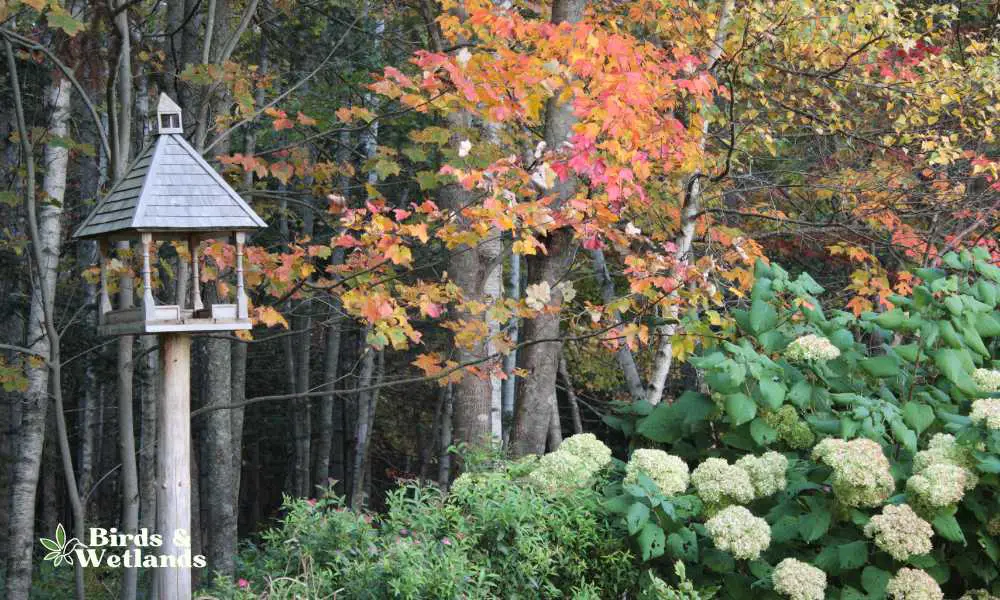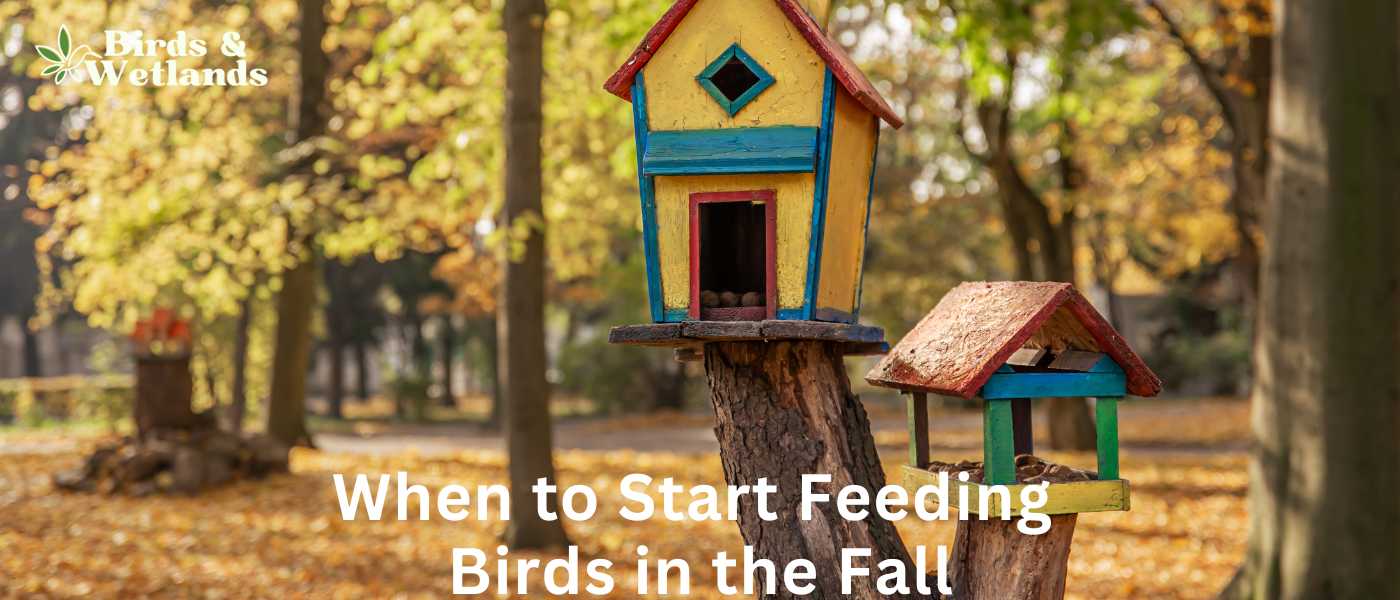Start feeding birds in early autumn, around late September or early October, when natural food sources begin to diminish. This is when many birds start to prepare for migration and need additional energy, while others start to gather food for the upcoming winter. Regular feeding can offer a crucial supplement to birds’ diets during this challenging period and will also encourage a variety of species to visit your garden.
Key Takeaways On Fall Bird Feeding
Things to Consider:
Feeding birds in the fall can provide them with a much-needed source of food as natural resources begin to dwindle. The precise timing for starting to feed birds in the fall may vary depending on your geographic location and the types of birds in your area. However, there are some general guidelines that you can follow:
- Begin in Early to Mid-Fall: It’s generally a good idea to start feeding birds in early to mid-fall. This allows birds to discover your feeders and become accustomed to them being a reliable food source before winter sets in.
- Watch for Migrating Birds: Many birds migrate in the fall, so this can be a good time to start feeding to provide them with an energy boost for their long journey. Watch for signs of migratory birds and consider providing food that these species particularly enjoy.
- Consider Local Climate: In some milder climates, natural food sources may be abundant well into fall, and supplemental feeding might not be necessary until late fall or even early winter. In colder climates where food becomes scarce earlier, you might want to start feeding in early fall.

Why feed birds in the fall?
Feeding birds in the autumn is crucial as natural food resources become scarcer. Many bird species are preparing for migration and require extra energy for the long journey. Resident birds begin to store food for the winter and appreciate the reliable food source. Furthermore, bird feeding provides an opportunity for bird watching, promoting engagement with nature and offering enjoyment to many people.
Help birds build up fat reserves.
Birds need to build up their fat reserves in the fall to prepare for the winter. As temperatures drop, food becomes scarce, and birds need to eat more to stay warm.
Putting bird feeders out in the fall can help local and visiting birds get the extra calories they need to build up their reserves. Bulking up will help them stay healthy and survive the winter months.
Attract a variety of birds.
Different bird species have different food preferences, so putting out a variety of bird feeders can help attract a range of birds such as blue jays, sparrows and mourning doves to your yard. You can use different types of feeders to offer different kinds of food, such as suet, seeds, and nectar.
Help declining bird populations.
Some bird species are in decline, and putting out bird feeders, especially in the fall, can help support their populations. By providing a reliable source of food, you can help birds survive the winter and increase their chances of breeding successfully in the spring. This can be especially important for species that are struggling to find enough food in their natural habitats.
Enjoy bird watching from the comfort of your home.
Bird watching is a popular pastime for many people. Putting out bird feeders in the fall can make it easier to observe birds from the comfort of your home. By placing feeders near a window, you can watch the birds come and go throughout the day. This can be a great way to relax and enjoy nature without having to venture outside.

When is the best time to feed wild birds in the fall?
| Region | Month Range for Starting Fall Bird Feeding |
|---|---|
| Northwest | September – October |
| Southwest | September – October |
| West | September – October |
| Midwest | October – November |
| Northeast | October – November |
| Southeast | October – November |
Please note that these are general guidelines and the specific timing of fall bird feeding may vary depending on local climate conditions and the behavior of resident birds. It’s important to pay attention to the cues from the migrating birds themselves, such as changes in their feeding patterns and the appearance of new species in the area.
What are the best bird foods for fall bird feeding?
Here are some of the best foods for birds to help them survive upcoming cold winter nights:
Bird Seed Mixes
Seeds are a good bird food in the autumn because they are abundant, nutritious, and easy to find. Additionally, seed mixes such as sunflower seed, are high in energy, protein, and essential nutrients, making them an ideal food for resident birds preparing for migration or winter.
To feed backyard birds seeds in the autumn, start by selecting a bird feeder that is appropriate for the types of birds you want to attract. Fill the feeder with a variety of high-quality mixed seed, such as black oil sunflower seeds. Place the feeder in a location that is easily visible to the birds but out of reach of predators.
Make sure to clean the feeder regularly to prevent the growth of mold and bacteria, which can harm fall birds. Finally, be patient and persistent, as it may take time for the birds to discover and start using the feeder.
When the temperature starts to freeze, those same birds will come back to your backyard buffet.
Black Oil Sunflower Seed
- High Nutrient Content: The Blue Seal Premium Black Oil Sunflower Wild Bird Seed is high in fat and protein, providing essential nutrients to wild birds especially during harsh winter months.
- Attracts Diverse Species: The seeds are known to attract a wide variety of wild birds, such as Northern Cardinals, Tufted Titmice, Mourning Doves, and Evening Grosbeaks, thereby enhancing your bird-watching experience.
- Increased Survival Rates: The presence of these bird seeds in your feeder can increase bird survival rates by up to 38%, contributing to the conservation of local bird populations.
- Promotes Overall Health: Offering a consistent and reliable source of feed like this can lead to less stress and greater overall health in the bird population visiting your garden.
Nuts
Nuts are good foods for autumn birds in the autumn because they are a rich source of energy and nutrients that can help the birds prepare for the winter months. Nuts are high in fat and protein, which are essential for maintaining the birds’ energy levels and body heat during the colder months.
Additionally, many types of nuts are also rich in vitamins and minerals, which can help support the birds’ overall health and immune system. Finally, nuts are a natural food source that many types of birds would naturally forage for in the wild, making them a great addition to any bird feeder.
Suet
Suet is a great energy source for migrant birds in early fall, especially for insect-eating birds like woodpeckers, nuthatches, and chickadees. Suet is a high-energy food that is made from animal fat, which can help birds maintain their body heat and energy levels during the colder months.
You can hang a suet feeder filled with suet to a tree branch or post. You can find suet cakes at many birding and garden stores or even make your own using a simple recipe of melted suet mixed with birdseed, dried fruit, and other ingredients.
Wild Bird Copper Suet Feeder
A Must-Have for Bird Lovers
- Triple Capacity: Hold up to 3 cakes or a large brick for continuous bird feeding.
- User-Friendly: The EZ Fill design ensures effortless reloading of bird feed.
- Weather-Proof: Its unique roof design keeps feed dry, ensuring birds can feast in any weather.
- Comfort-First Design: The vinyl coating prevents birds’ feet from freezing in winter or burning in summer.
More feeding tips for attracting fall feeder birds
- Not all hummingbirds are migratory so you can still put out hummingbird feeders or nectar feeders in autumn to attract these tiny birds to your garden before winter arrives.
- Many birds take a long journey south during fall migrations and most birds use stopover sites to refuel and rest. So putting seed feeders filled with sunflower hearts or peanut hearts can help them.
- Keep feeders clean at all times. Remove any uneaten suet, seeds and other foods from feeders and replace them regularly.
- Leave leaf litter in your backyard to provide homes for insects and small animals which an attract many species of birds such as sparrows.
- Keep squirrels out of your tube feeders before by putting the feeders in a cage or surrounding them with mesh wire.




